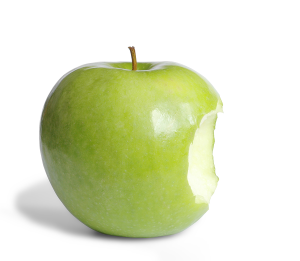 I invited Stacy Whitman of SchoolBites.com to do this Q&A because I was so inspired by her blog.
I invited Stacy Whitman of SchoolBites.com to do this Q&A because I was so inspired by her blog.
Her tagline is: “One mom’s crusade for better nourished kids at school (and at home!). Right on! Her bio is at the bottom of the page. For her inspiring story of how she inspired change at her son’s school, read on!
Before getting started, I must admit to having just polished off the most exquisite dish of mousse au chocolat (recipe from French Kids Eat Everything). I can’t believe that I made this elegant dessert in less than 15 minutes plus chilling time. To me, it is definitive proof that the French know their stuff when it comes to food.
I read French Kids Eat Everything with particular interest in the French approach to feeding kids in school. If you’ve read the book, you know that learning about food is an important part of the French education. Unlike in North America, French school children sit down to elaborate 4-course meals cooked from scratch. They sit at tables covered with tablecloths and eat off China plates. They are taught to love fish and beets the way that North American kids are taught to like grilled cheese and ketchup.
Earlier this year, I started blogging about all the not-so-healthy foods being served up in my son’s elementary school. In the cafeteria, I mostly saw pizza, mac and cheese, and chocolate milk. At classroom celebrations, it was cupcakes, cookies and candy. On signs advertising student events, I saw promises of hot dogs and soda. And let’s not forget the monthly bake sales pedaling brownies and Rice Krispie treats. Where were the fresh fruits, vegetables and whole grains? And why weren’t we educating our kids about how to eat?
I naively expected the school to be a safe haven from the hordes of junk food that North American kids encounter every day. Instead, it was acting as a supplier. Even worse, students were being rewarded with candy, ice cream and other sweets—a practice frowned upon by major medical organizations because it only enhances cravings and teaches them to comfort themselves with food.
This scenario is par for the course in American schools—a very sad fact given that one-third of our children is currently overweight or obese, and almost one in four adolescents is either diabetic or on the brink of becoming so, according to a recent study in the journal Pediatrics.
Last spring, I set out to change the status quo at my son’s school. I helped start a Wellness Committee with another mom. Six months later, I’m happy to report that we’ve already made some great progress. We launched monthly “Food and Fun” classes (involving nutrition education and food tastings) for the 5th grade with the hopes of expanding them to the rest of the school. Our principal sent out a school-wide request for healthier snacks at school events and most parents seem to be embracing the change. With the United States Department of Agriculture (USDA)’s new school meal standards (effective as of July), the cafeteria offerings are looking better, too. But still, the vittles and food education are a far cry from what’s typically found in France.
Regretfully, I don’t think that we’ll ever be able to achieve the French cantine in North American schools. Our food culture is just too different; budgetary constraints and red tape also make it difficult for schools to make sweeping changes. As I’ve learned from my own journey, however, the situation isn’t hopeless. While we may never be able to achieve what the French have, it is possible to make improvements. Some of the ways in which we could learn from the French:
Nutrition education for staff One reason the French approach works is because everyone-parents, teachers, school directors, etc.—is on the same page about food. In North America, educating school staff on healthy eating and how to be positive and supportive when feeding kids could be instrumental toward creating a healthier food environment. Wellness workshops and informational handouts for school employees would be a good starting place. FoodFight is an organization that specializes in teacher wellness programs. On her website, child feeding expert Ellyn Satter, R.D., also offers helpful guidelines for school nutrition staff.
Food lessons for students French children are taught about food through classroom lessons, food tastings, school gardens and school meals (during which all children eat the same food; brown bags from home aren’t allowed). Making food ed a mandatory part of K-12 school curriculums in North America could help children learn the basics that many aren’t learning at home.
Volunteer “food coaches” Young children need guidance when it comes to making healthy choices. One idea is to train parents to act as “food coaches” to steer kids through the lunch line and help at the table. Duties could include anything from peeling an orange to gently encouraging a child to try a new food.
Longer lunch breaks By law, French children must spend a minimum of 30 minutes at the lunch table, giving them adequate time to savor their food. At many North American schools, kids only get 10 to 20 minutes for lunch (which includes eating as well as navigating the lunch line)—not nearly enough for many children, especially younger ones, to have a satisfying meal.
No vending machines The French, who are not fans of snacking, placed a ban on school vending machines back in 2005. While a number of our schools (including my son’s) have eliminated them as well, they still exist in an estimated 27 percent of elementary, 87 percent of middle, and nearly all high schools in the United States, according to the Center for Science in the Public Interest. Some schools have made the switch to healthy” vending machines dispensing items like dried fruit and bottled water versus candy and soda. New standards for competitive foods (foods and beverages sold outside of the federally reimbursable school meal program)—expected soon from the United States Department of Agriculture (USDA)—may force others to follow suit.
More farm-fresh food School food made with fresh, locally sourced ingredients is par for the course in France. In North America, not so much. Many American schools still outsource to food service management companies such as Aramar and Sodhexo, which translates to more processed food. The USDA’s Farm to School Program and organizations like The Farm to School Network.
Water during meals In France, strict Ministry of Education regulations require that children only drink water at lunch. In American schools, on the other hand, flavored milks, juices and sometimes even soda reign supreme. The 2010 Healthy, Hunger-Free Kids Act includes a provision that free drinking water be available to students during school meals. The California-based Water in Schools campaign has helpful information on how to implement it at your school.
In North America, school food is getting lots of attention at the moment. Michelle Obama, Jamie Oliver, Chef Ann Cooper, and organizations including Alliance for a Healthier Generation, Rudd ‘Roots Parents, and Whole Kids Foundation and The Farm to School Network are helping to educate schools and parents about how to improve school food. We clearly have much work to do, but at least people are talking and momentum is building. And as I’ve learned firsthand, parents can be very effective advocates for change. So take a lesson from the French and stand up for healthier food and nutrition policies at your child’s school. There are many school food resources and links on my website to help get you started.
 BIO: Stacy Whitman is the mother behind the blog School Bites: One Mom’s Crusade for Better Nourished Kids at School (and at Home!). Before turning to blogging, she worked as a health and fitness editor at national magazines including Shape and Parenting. She lives in Ketchum, Idaho, with her husband, 7-year-old son and 4-year-old twins (a boy and a girl).
BIO: Stacy Whitman is the mother behind the blog School Bites: One Mom’s Crusade for Better Nourished Kids at School (and at Home!). Before turning to blogging, she worked as a health and fitness editor at national magazines including Shape and Parenting. She lives in Ketchum, Idaho, with her husband, 7-year-old son and 4-year-old twins (a boy and a girl).

Pingback: What American Schools Can Learn from the French Approach to Food
What a great initiative! My son (we’re French living in the US) isn’t school age yet, but I can picture myself doing very similar endeavors in his school in the future!!! Thank you for sharing.
LikeLike